Definition
Anasarca (pronunciation: an′ă-sar′kă; ICD-9: 782.3), also known as hydrosarca or dropsy, is the medical jargon for generalized edema.
The presence of marked swelling of the entire body signifies a severe underlying condition. In contrast with the word “swelling,” the whole body is grossly edematous and not just a certain part.
The edema is due to accumulation of fluid in the subcutaneous tissue. Quantitatively, a fluid gain of ≥3L is detected for a person to develop anasarca (1,4)

Picture 1: Define Anasarca
Image Source: dearnurses.blogspot.com
Causes
Anasarca is generally due to water retention, blood vessel defect, and lymphatic obstruction. These disturbances may be caused by the following (3)
- Congestive heart failure (CHF)
- Excessive salt or sodium intake
- Burns
- Hypoalbuminemia (low albumin levels)
- Pregnancy: Pre-eclampsia or Eclampsia
- Thyroid problems
- POEMS syndrome
- Clarkson syndrome or systemic capillary leak syndrome
- Amyloidosis
- Severe malnutrition: Marasmus, Kwashiorkor
- Liver failure
- Kidney failure
- Hookworm infestation
- Drugs
Pictures

Picture 2: A child with anasarca because of nephrosis secondary to malaria
Image Source: en.wikipedia.org

Picture 3: Anasarca from Nephrotic Syndrome
This patient suffers from nephrotic syndrome. The examiner tests for pitting edema of the abdominal wall.
Image Source: Just In Time Medicine. Michigan Stage University.
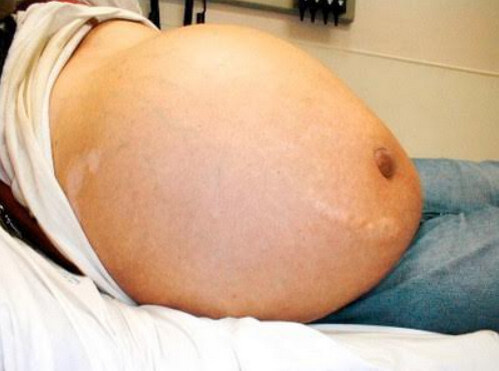
Picture 4: Ascites is defined as accumulation of fluid in the abdominal cavity.
Image Source: howshealth.com
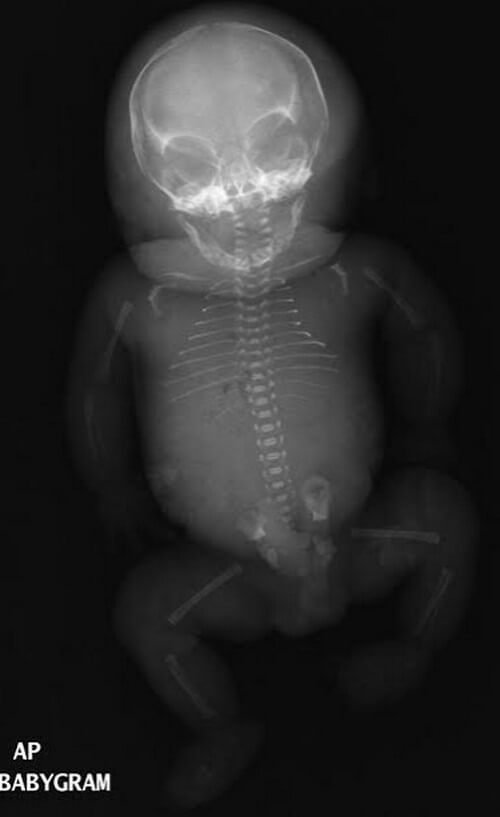
Picture 5: AP babygram detects fetal anasarca seen in hydrops fetalis.
Image Source: Case courtesy of Dr. Hani Al Salam, Radiopaedia.org, rID: 9448
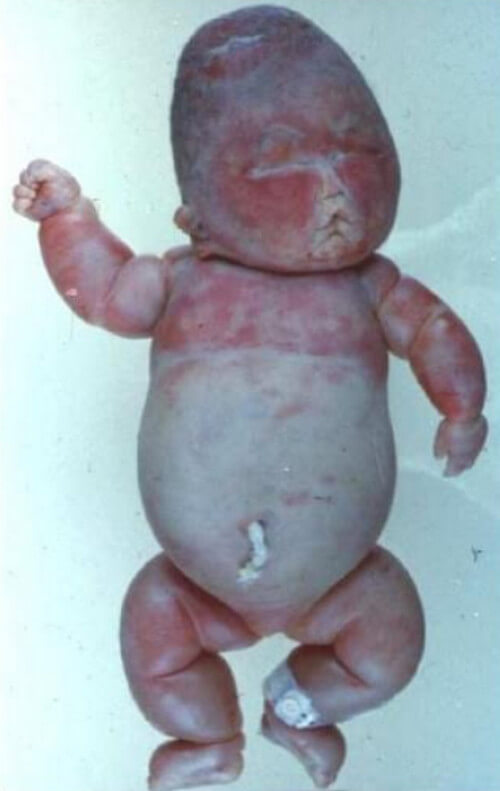
Picture 6: Gross features of fetal anasarca
Image Source: Hemodynamic Disorders in Slideshare.
Pathophysiology
In the presence of hypoalbuminemia as seen in nephrotic syndrome or other disease entities, anasarca occurs as a result of low osmotic pressure in the capillaries. The osmotic pressure is the pulling force that keeps the fluid within the blood vessels. If osmotic pressure is low, fluid leaks out or extravasates into the interstitium, hence the edema. In anasarca, the decreased capillary osmotic pressure is systemic, giving you a generalized edema or swelling. Anasarca frequently presents as pitting edema and it occurs early in the ankles, feet, and around the eyes (periorbital edema)(5)
Another pathophysiology of anasarca worth discussing is diabetic nephropathy. Diabetes mellitus is very rampant and as the morbidity rate increases, cases of diabetic nephropathy as one of its complications also increase. In diabetes mellitus, there is hyperglycemia and hypertension. These two affect the glomeruli of the kidneys by increasing the thickness of its basement membrane, causing the glomeruli to enlarge.
As a result, Kimmelstiel-Wilson nodules develop, obstructing the glomerular blood flow and damaging the nephrons (kidney cells). With glomerular enlargement comes proteinuria (presence of protein in the urine). Normal, healthy individuals do not have proteins in their urine. As the proteins continue to spill into the urine, more nephrons become destroyed, worsening the proteinuria, and the cycle goes on and on until the condition progresses to renal failure.
Proteins normally increase the osmotic pressure. But because these are spilled into the urine, there will be less proteins in the plasma, decreasing the osmotic pressure. If osmotic pressure is low, fluid leaks out or extravasates into the interstitium, causing anasarca(5)
Fetuses can also have generalized swelling in its intrauterine life. Fetal anasarca occurs in hydrops fetalis. In this condition, there is increased capillary permeability and obstructed lymphatic vessels, resulting to extravasation of fluid into the subcutaneous tissue. As a result, the fetal subcutaneous tissue appears to be 5mm thicker than normal(6)
Ascites is defined as the accumulation of fluid in the abdominal cavity. Although there are a number of risk factors (i.e., decreased albumin levels, low osmotic pressure, increased epinephrine and norepinephrine levels), there are few explanations for ascites. The most convincing among them is the peripheral arterial vasodilation hypothesis suggesting that ascites is caused by portal hypertension which leads to vasodilation.
As a result, there will be decreased blood volume in the arteries because of sluggish blood flow. The disease worsens, stimulating neurohumoral excitation, causing sodium retention in the kidneys and expanded plasma volume. The excess fluid goes into the abdominal cavity, hence the ascites .(7)
Diagnosis
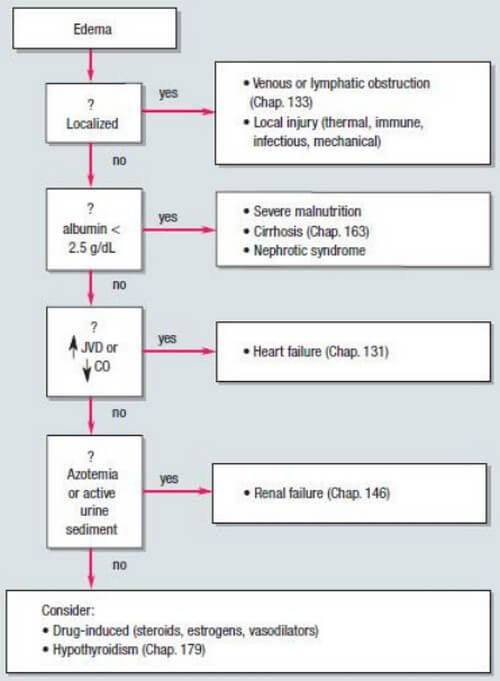
Picture 7: Diagnostic Approach to Edema
Image Source: Harrison’s Manual of Medicine 17th edition.
Refer to the illustration above as we discuss how edema is diagnosed. If you have edema, the first question to be asked is “Is it localized or generalized?” If it is localized, it may be due to venous obstruction, lymphatic obstruction, or local injury. So more often than not, there is nothing to worry about as it will subside as the obstruction is removed and as the injury heals.
But if we are talking about generalized edema or anasarca, then we have a big problem as it mirrors a serious underlying condition. Your doctor will request for laboratory test to determine hypoalbuminemia (albumin level of <2.5mg/dl). If anasarca is due to hypoalbuminemia, the patient may either have severe malnutrition, liver cirrhosis, or nephrotic syndrome.
If the albumin is normal, a common underlying cause is heart failure and this can be observed in patients with jugular venous distention (JVD) on the side of the neck or decreased cardiac output (CO) as the heart fails to pump sufficient blood to cater the needs of the entire body.
If there is no JVD or if the CO is normal, we look at the kidneys. Presence of azotemia or active urine sediment indicates renal failure.
If is not due to renal failure, it may be caused by hypothyroidism or it may be drug-induced (steroids, estrogens, vasodilators)(4)
Treatment
Anasarca is not a disease entity by itself but rather, it is a sign that something severe is going on inside the body. To get rid of anasarca, we have to accurately determine the underlying cause and treat it. The following are the most common treatment modalities used in patients with anasarca (4,8)
- Where sodium goes, water follows, so reduce sodium/salt intake to <500mg/day.
- Bed rest is required for faster recovery especially if the cause of anasarca is congestive heart failure or liver cirrhosis.
- For swelling of the lower extremities, lie down flat on your back and elevate your legs and feet against the wall.
- Compression stockings also help.
If the laboratory test detected severe hyponatremia (<132 mmol/L), restrict water intake to <1.5L/day to prevent further lowering of sodium levels in the blood, as what happens in dilutional hyponatremia when you drink excess water.
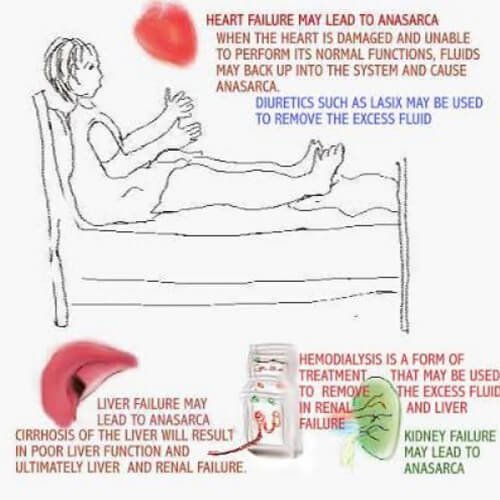
Picture 8: Diuretics and/or hemodialysis for anasarca
Image Source: dearnurses.blogspot.com
- Diuretics are used for congestive heart failure, pulmonary edema, and excessive sodium ingestion. Potassium-sparing diuretics may be added to loop diuretics for a better outcome. Reduce the dosage if desired weight is achieved. Weight loss with diuretics use should only be 1-1.5 kg/day.
- For liver and kidney failure, hemodialysis may be used to get rid of the excessive interstitial fluid.
- In congestive heart failure, do not overuse diuretics as it may lead to further decreased cardiac output, azotemia (accumulation of proteins in the blood), and hypokalemia (decreased serum potassium levels).
- In anasarca caused by liver diseases, spironolactone (a potassium-sparing diuretic) is the diuretic of choice. Thiazides or loop diuretics may be added but giving diuretics should be closely monitored because overuse may backfire to a worse complication like hepatic encephalopathy.
- Thyroid hormone replacement is given to patients with hypothyroidism.
- In patients with burns, generous fluid and electrolyte replacement is extremely important.
- For malnourished patients, adequate food and fluid intake will cure anasarca.
- Stop using the drug causing anasarca, if it is drug-induced.
Anasarca is not a disease entity on its own. It signifies a severe underlying disease. If you have this, consult your doctor. Treatment is necessary.
References
- Medilexicon. Available from: http://www.medilexicon.com/medicaldictionary.php?t=3408
- Encyclopedia Britannica. Available from: http://www.britannica.com/science/anasarca
- Anasarca: Definition, Causes & Treatment. Study.com. Available from: http://study.com/academy/lesson/anasarca-definition-causes-treatment.html#lesson
- Fauci AS, et al. Harrison’s Manual of Medicine 17th edition. McGraw-Hill Medical. 2009.
- Corwin EJ. Handbook of Pathophysiology 3rd edition. Lippincott Williams & Wilkins. 2008.
- Fetal Anasarca in Radiopaedia.org. Available from: http://radiopaedia.org/articles/fetal-anasarca
- Emedicine/Medscape. Available from: http://emedicine.medscape.com/article/170907-overview#a5
- Medicalopedia. Available from: http://medicalopedia.org/3092/anasarca/




